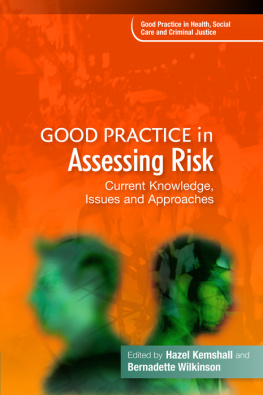RISK IN PROBATION PRACTICE
First published 1998 by Ashgate Publishing
Reissued 2018 by Routledge
2 Park Square, Milton Park, Abingdon, Oxon, OX14 4RN
711 Third Avenue, New York, NY 10017, USA
Routledge is an imprint of the Taylor & Francis Group, an informa business
Copyright Hazel Kemshall 1998
All rights reserved. No part of this book may be reprinted or reproduced or utilised in any form or by any electronic, mechanical, or other means, now known or hereafter invented, including photocopying and recording, or in any information storage or retrieval system, without permission in writing from the publishers.
Notice:
Product or corporate names may be trademarks or registered trademarks, and are used only for identification and explanation without intent to infringe.
Publishers Note
The publisher has gone to great lengths to ensure the quality of this reprint but points out that some imperfections in the original copies may be apparent.
Disclaimer
The publisher has made every effort to trace copyright holders and welcomes correspondence from those they have been unable to contact.
A Library of Congress record exists under LC control number: 98073401
ISBN 13: 978-0-367-00099-8 (hbk)
ISBN 13: 978-0-367-00102-5 (pbk)
ISBN 13: 978-0-429-44451-7 (ebk)
Many people have supported my work on risk and stimulated my thinking over this four year period.
Particular thanks must go to Gillian Hundt for starting me on the research process, Liz Ross for much patient mentoring on methodology, and Paul Holt for assistance with the analysis. My thanks are extended to Eric Morrell, Chief Probation Officer, and to Liz Stafford, Research and Information Officer for facilitating research access in the West Midlands Probation Service; to Sue Roberts of the Home Office Probation Training Section for entrusting me with the training brief; and to Gill MacKenzie, Chief Probation Officer of Gloucestershire for ensuring Association of Chief Officer support at crucial moments. Gratitude is expressed to my colleague Jacki Pritchard who provided key advice and editorial comment, and to Ann Lane and Sue Gilbert who provided excellent secretarial advice and support. The project was sponsored by the Economic and Social Research Councils Risk and Human Behaviour programme grant number L211252018.
However, this work would not have been completed without the unstinting support of all staff in the study. Their trust and frank co-operation are deeply appreciated.
A list of abbreviations is provided to assist readers.
PSA: Probation Service Assistant.
ASW: Assistant Warden (Hostels).
PO: Probation Officer.
SPO: Senior Probation Officer.
ACPO: Assistant Chief Probation Officer.
NAPO: National Association of Probation Officers.
ACOP: Association of Chief Officers of Probation.
HMIP: Her Majestys Inspectorate of Probation.
NPRIE: National Probation Research and Information Exchange.
...Who performed this screening? How does it work? Who is the man or woman who made the final and fateful decision that the crime-sodden Compton was suitable company for the most vulnerable section of society? The ...Probation Service must answer these questions. Until we get the fullest of explanations, we mustnt trust their judgement further (Maureen Messant, Birmingham Evening Mail, 1996).
On October 25th 1996 the Birmingham Evening Mail published an editorial entitled: Were sick of these outrageous decisions (p.15), in which the risk assessment practice of the Probation Service was severely criticised. The case concerned the brutal murder of a recipient of community service by an offender who had made contact with the victim during the completion of his community service order. The outrageous decision reflected media and public perceptions that the Probation Service had placed a vulnerable person at risk through the failure of its risk assessment procedures.
Whilst a subsequent editorial less virulently apportioned blame for the failure of the risk assessment to the poor communication between Probation and the Crown Prosecution Service (Evening Mail 16th July 1997, p.6); both editorials illustrate the centrality of risk practice to probation work, and the high costs to individuals and the agency when something goes wrong.
Assessing the riskiness of offenders for whom it has a statutory responsibility is now the core business of the Probation Service. Establishing and responding to the risk levels of offenders requires new and reliable techniques of risk assessment, risk analysis, and risk management Staff and managers in Probation face daily decisions and dilemmas in these areas, most often about individual risk levels and how to avoid, control or minimise risk. Risk has become the dominant raison dtre of the Service, supplanting ideologies of need, welfare or indeed rehabilitation as key organising principles of service provision (Kemshall et al 1997). Risk is now the central focus of practitioner activity and a key area of scrutiny and accountability for managers.
As risk becomes the primary principle for the organisation and delivery of probation work, the Service is undergoing rapid change in both its key concerns and its fundamental relationships with offenders. Risk is the key strategic mechanism for the allocation of resources and as such it entails a differing categorisation of offenders than the more traditional ones of need and rehabilitation. An analysis of risk in probation practice provides an important insight into the changing nature of probation work and of the impact of this change upon the daily practices of staff and managers.
Scope and structure of the book
The book has its origins in research conducted under the Economic and Social Research Councils (ESRC) Risk and Human Behaviour Programme (grant number L211252018), launched in 1993. The Programme initiative reflected increased societal concern with risk (Beck 1992), particularly with the accurate identification of hazards and their reduction. The programme objectives relevant to the present study were:
The extent to which perceptions of risk vary.
The extent to which risk assessments are influenced by value judgements and biases.
How different understandings of risk and methods of risk assessment are reconciled in policy-making and implemented by frontline risk assessors.
The impact of conditions of uncertainty upon risk decision making, in particular upon individuals capacity to understand and use probability data on risk.
In 1993 the Probation Service was beginning to digest and adapt to its growing role in the assessment and management of offender risk. The Home Office instruction to Chief Probation Officers to set up and maintain registers of Potentially Dangerous Offenders (Home Office 1988), began to focus the Services attention on the issues of credible identification and management In addition, the risk reduction and public protection themes of the Criminal Justice Act 1991 (Wasik and Taylor 1991) gave legislative impetus to the Services risk agenda. This presented an opportunity to investigate the ESRCs major objectives in the context of both local and national efforts to frame and implement policies on offender risk. The research study followed this challenging period (1993-1997), and the contents of the book reflect this time of change, tension and the daily reality of grappling with risk on the ground. In capturing what has been to some extent the moveable feast of risk, the book imposes a logic and structure cm the material which was not always apparent either in the activities of the researcher or in the activities of service managers and staff. However, for ease of access and presentation the book is divided into three parts.





